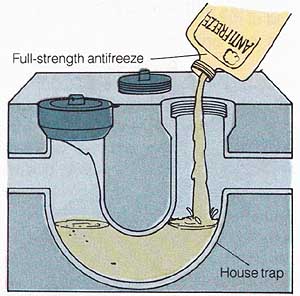A faucet that refuses to yield water is the first sign of frozen pipes. If a severe cold snap hits, prevent freezing and subsequent bursting of pipes by following the suggestions given below. Even if the pipes do freeze, you can thaw them before they burst if you act quickly.
Preventing frozen pipes
Here’s how to keep your pipes from freezing:
• Keep a trickle of water running from the faucets.
• Beam a small lamp or heater at exposed pipes.
• Wrap uninsulated pipes with news papers, heating wires, foam, or tape.
• Keep doors ajar between heated and unheated rooms.
Thawing frozen pipes
If a pipe freezes, first shut off the main water supply and open the faucet nearest the frozen pipe so it can drain as it thaws. Waterproof the area with drop cloths in case leaks occur, then use one of the following methods to warm the frozen pipe (see Ill. 97). Be sure to work from the faucet toward the iced-up area.
• Propane torch. With a flame- spreading nozzle, the torch will quickly thaw a frozen pipe.
CAUTION: Never let the pipe get too hot to touch.
• Hair dryer. Used like the torch, a dryer will gently defrost the pipe.
• Heating pad. A gradual but effective method, a heating pad wraps a length of pipe with warmth.
• Heat lamp. For freezes concealed behind walls, floors, or ceilings, beam a heat lamp 8 or more inches from the wall surface.
• Hot water. If no other method is available, wrap the pipe (except plastic) in rags and pour boiling water on it. Expect a mess.

Ill. 97. A variety of pipe-thawing techniques
Closing down plumbing for the winter Homeowners who used to simply turn down the thermostat in a vacated house for the winter are now closing down the plumbing system because of prohibitively high energy costs. Winterizing your plumbing is a virtually cost-free alternative to frozen pipes. First, turn off the main shutoff valve or have the water company turn off service to the house. Starting at the top floor, open all faucets, indoor and out. When the last of the water has dripped from the taps, open the plug at the main shutoff valve (if possible — you may have to contact the water company) and let it drain. Turn off the power to the water heater and open its drain valve. Empty water from the traps under sinks, tubs, and showers by opening cleanout plugs or removing the traps, if necessary. Empty toilet bowls and tanks, then pour a gallon of automotive antifreeze/water solution into each toilet bowl. Finally, if your home has a basement floor drain or a main house trap, fill each with full-strength automotive antifreeze (see Ill. A).
|
